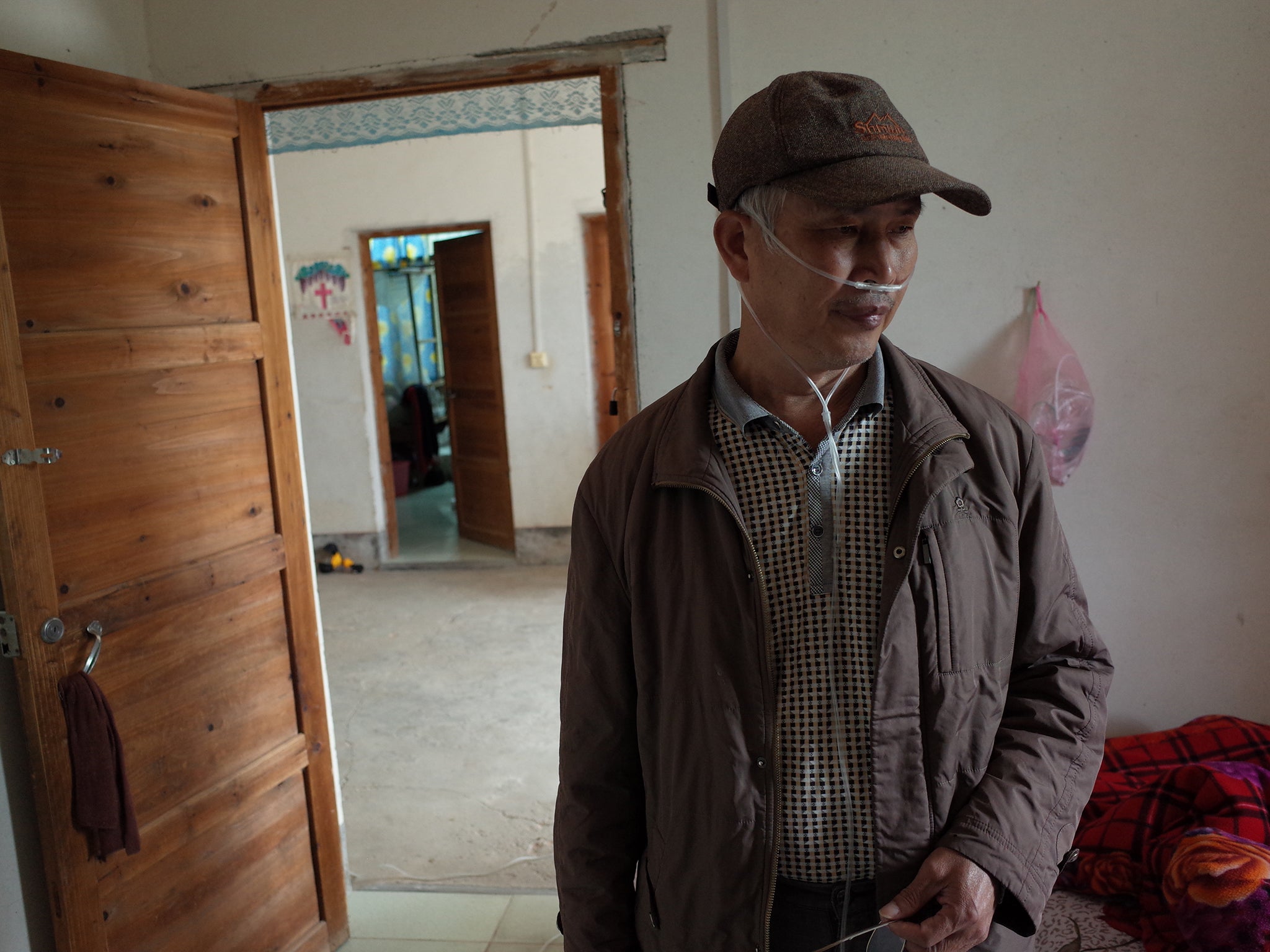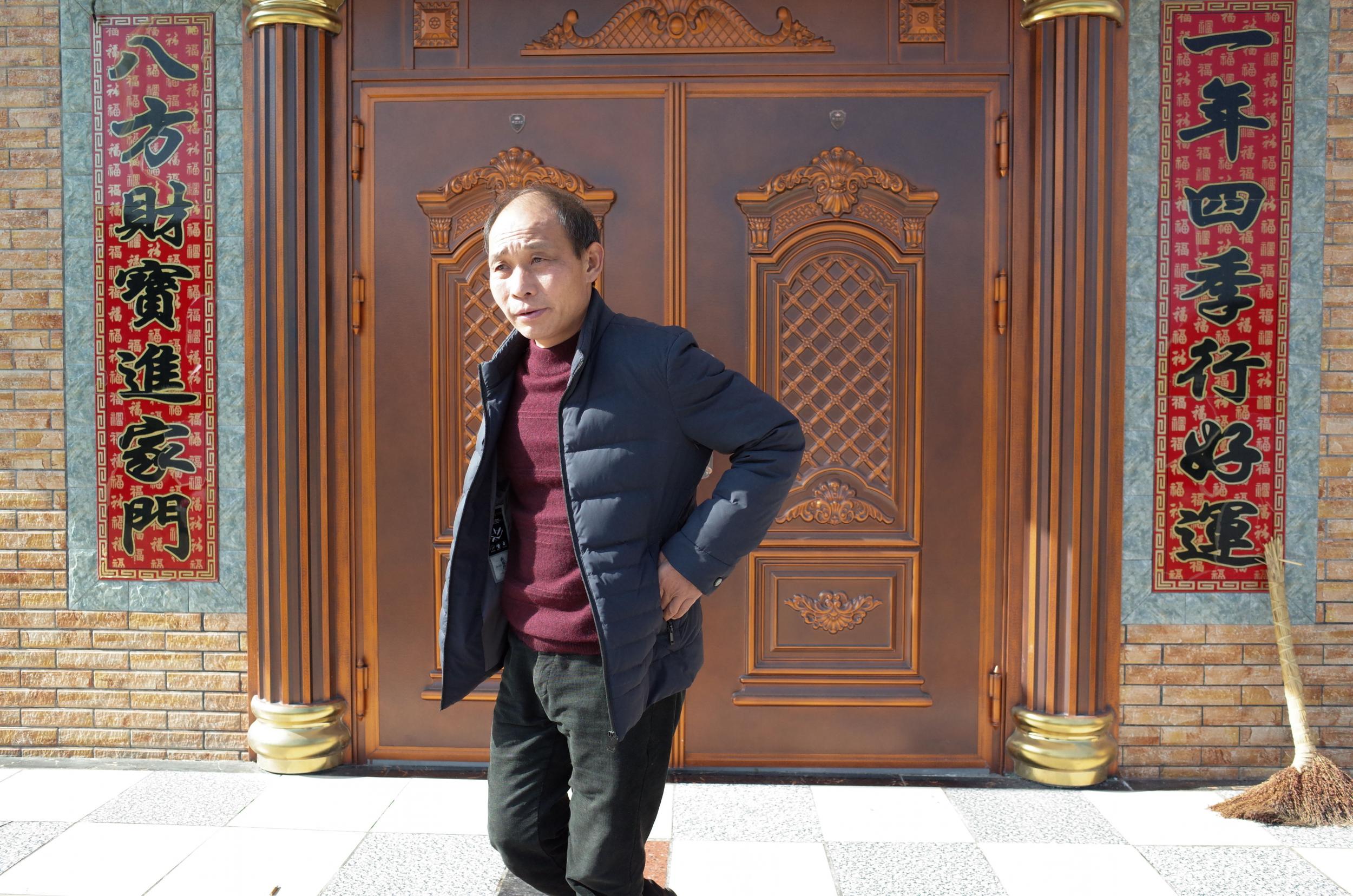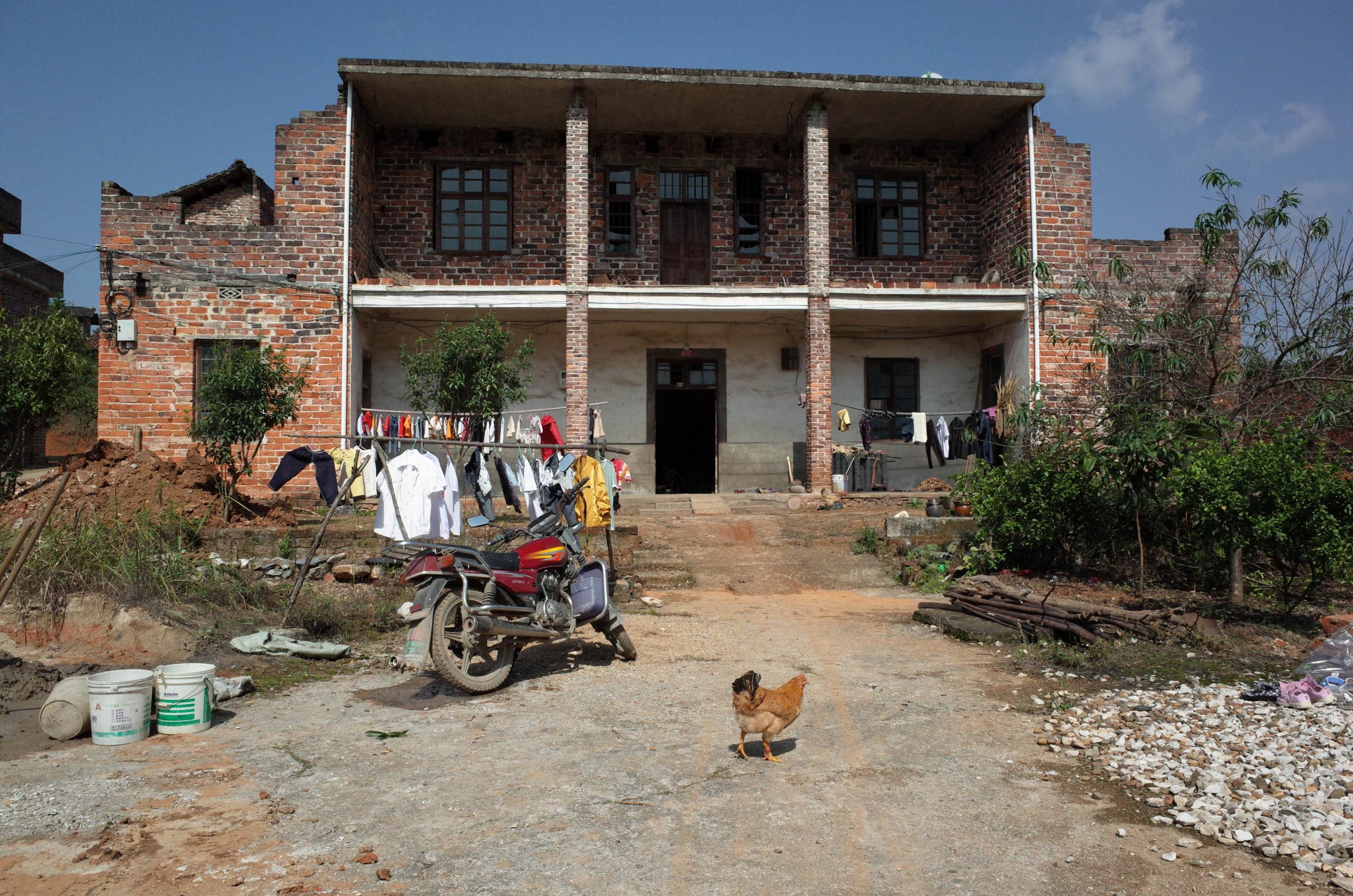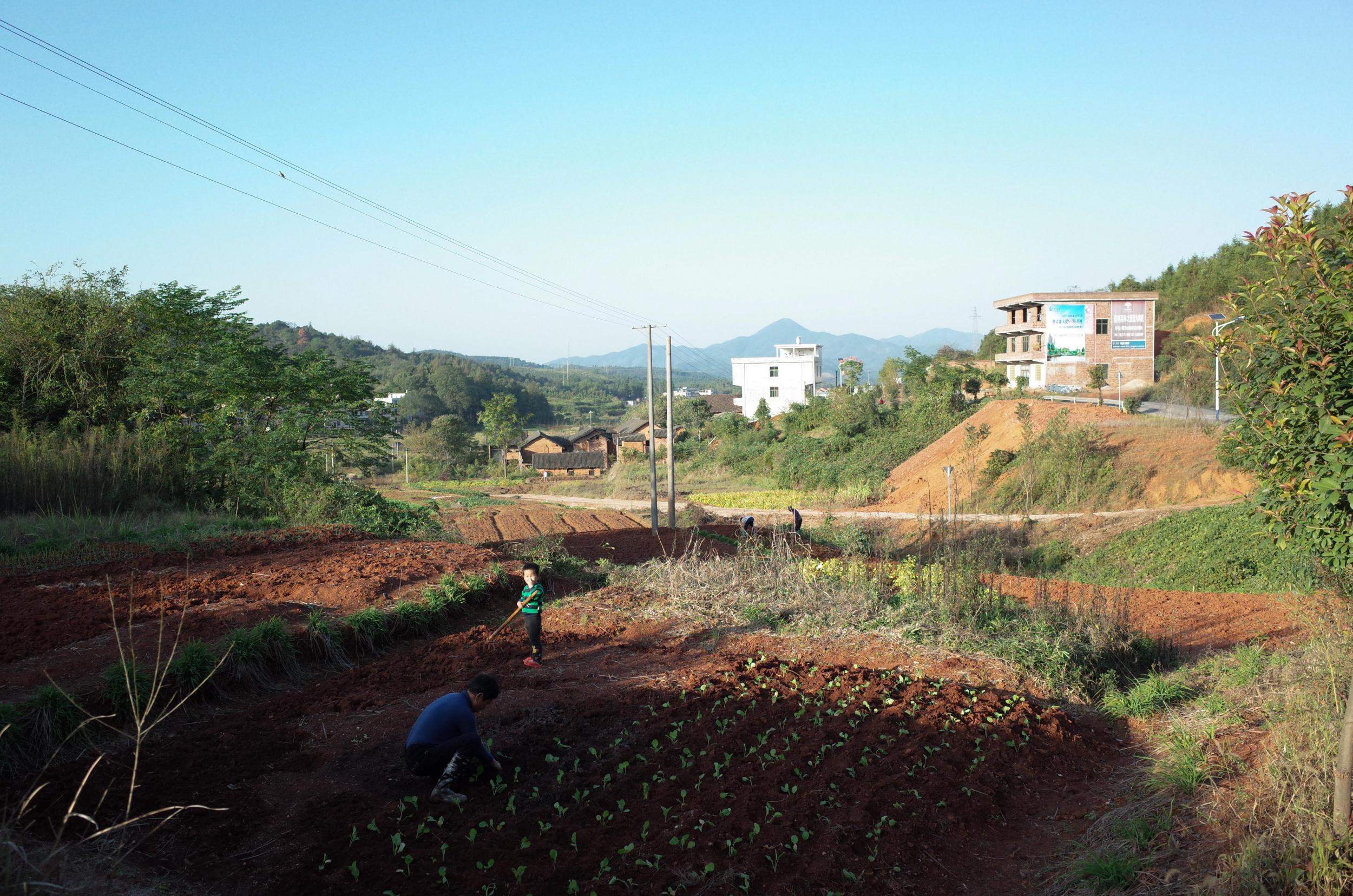How Shenzhen’s hidden silicosis crisis led to a mass suicide attempt
Workers who built the Chinese city over decades didn’t know the irreversible harm of inhaling silica dust that caked their faces, writes Gerry Shih

Your support helps us to tell the story
From reproductive rights to climate change to Big Tech, The Independent is on the ground when the story is developing. Whether it's investigating the financials of Elon Musk's pro-Trump PAC or producing our latest documentary, 'The A Word', which shines a light on the American women fighting for reproductive rights, we know how important it is to parse out the facts from the messaging.
At such a critical moment in US history, we need reporters on the ground. Your donation allows us to keep sending journalists to speak to both sides of the story.
The Independent is trusted by Americans across the entire political spectrum. And unlike many other quality news outlets, we choose not to lock Americans out of our reporting and analysis with paywalls. We believe quality journalism should be available to everyone, paid for by those who can afford it.
Your support makes all the difference.Ill and defeated, Xu Chunlin approaches the railing, the limits of a search for justice. Before him is a 30ft plunge into Shenzhen’s rush-hour traffic and behind him stands police he has just clashed with. On the overpass with him are about 80 other former construction workers considering the same desperate calculus: leap now? Or wait to die when their lungs give out?
The journey that led them to this bridge began in the early 1990s. The men were young and healthy then, wide-eyed migrant labourers from rural Hunan province. Shenzhen was a scruffy border boomtown to the south – not yet today’s cosmopolitan hub of 12 million – where they flocked for off-the-books jobs as drillers.
Many Hunanese worked for years, even decades, boring into the bedrock to build subway lines and the foundations of Shenzhen’s whole cityscape. But they didn’t know the inadequacy of the £1 cotton masks they were given, or the irreversible harm of inhaling silica dust that caked their faces once their drills bit into granite-streaked crust.
More than 100 former labourers from Hunan have died in the past decade from silicosis, an incurable condition caused by inhaled dust particles that scar and harden the lungs.
Justice doesn’t exist in this society. It has glory and wealth and skyscrapers built on our bones
About 600 more are suffering or slowly dying, the leaders of worker groups say. Three poor communities in Hunan that once survived off their earnings – even saw progress – are now mired in debt and grief while surviving workers spend their little savings and energy to clamour for compensation. The lives of Hunan’s drillers trace China’s diverging realities.
One story is reflected in the gleaming skylines they built: the backdrop for a prosperous middle class of 400 million people who live in China’s cities and power its economy. Another story is framed by struggle: a vast, rural underclass still toils in hazardous conditions, lacking documentation or means to seek redress except through confrontation with the government. Forty years after China shifted away from its socialist system – and the promise of cradle-to-grave care for workers – the country is settling hard questions accumulated in the rush to modernity.

Who benefited and who suffered? Who is owed compensation and who should pay up? Since early 2018, Hunan’s ailing drillers, led by Xu and others, have travelled more than a dozen times to Shenzhen to demand help. In early November 2018, hundreds of them occupied a government complex before police dispersed them with batons and pepper spray – further aggravating their weak lungs.
It was during that standoff – according to the accounts of four protesters, activists and news gatherers – that workers cornered by police on an overpass threatened to die by mass suicide by hurling themselves onto an eight-lane highway. Xu, one of the protest leaders that night, says he was ready to die for the cause. But he also feels responsible for these men, he later explains. He was one of the first Hunanese to bring fellow villagers to Shenzhen in the 1990s, setting off a chain of success and tragedy that would un-spool over 25 years.
Standing on that overpass, Xu says he yelled at the men to back away from the ledge and the madness. Keep calm, he told them, and fight another day. “China is like a cart. It won’t move forward if you don’t push,” he says. “If you’re not afraid of dying, you can accomplish anything in this country.”
Steep sandstone ravines carve across Sangzhi county, a part of Hunan province with little industry or even agriculture. But multistory homes with faux-European balustrades line county road 420. They are the rewards of labouring in cities like Shenzhen – and monuments to the human cost. “Everyone builds a big house and then there’s no one to live in it,” Gu Zhongping, a former driller, says as he drives along, pointing out homes with a former Shenzhen worker dying or dead.
Gu Hejian, in the house with red posters for his son’s wedding, doesn’t expect to live much longer. Zhong Yichuan, who lived behind a corner store, died two years ago. Wang Zhaogang died in April and was buried by 10 ill workers counting the days themselves. More than 26 former drillers in Sangzhi county have died of lung disease since 2009, according to residents, who say deaths are accelerating, with about 100 others who are seriously ill. In two other Hunan counties, Leiyang and Miluo, about 500 villagers who worked in Shenzhen have been diagnosed, according to workers’ representatives.
In 2018, about 873,000 Chinese workers had pneumoconiosis, up from about 559,000 in 2000. The true number of sufferers is estimated to be much higher – possibly about 6 million
Although official figures are unavailable, a Hunan city-level document found online supported the villagers’ claims. A 2017 health check showed that 290 villagers, mostly in Sangzhi, had silicosis. Work-related lung diseases have held steady or declined in developed countries as jobs such as coal mining waned and safety standards rose. In China, cases are proliferating. In 2018, about 873,000 Chinese workers had pneumoconiosis, a broad class of lung disease, up from about 559,000 in 2000, according to China’s National Health Commission. Love Save Pneumoconiosis, a Beijing nonprofit, estimates the true number of sufferers to be much higher – possibly about 6 million.
Chinese officials, who are drawing up new plans to study the crisis, say 23 million workers are at risk of getting the disease. That’s far more than the 11.5 million at-risk workers in India, 2 million in the United States and 1.7 million in Europe estimated by health authorities and researchers. Workers who inhale dust and tiny mineral crystals found in rock and sand do not immediately feel symptoms. But over months, sometimes decades, the lodged particles do devastating damage.
Walking, even talking, becomes difficult. Lying flat creates the sensation of suffocation, so most patients sleep sitting next to a small oxygen machine. In the latter stages, they suffer heavy wheezing, steep weight loss, frequent bouts of colds and fevers. Pneumonia and tuberculosis can easily turn fatal. Sooner or later, the lungs simply give out. Behind a trash-strewn basketball court that serves as a village square in Sangzhi county, a country doctor, Li Li, watches Cheng Xiangyong, a 49-year-old doubled over the couch in her office, coughing up long, thick goop.
“He should have one and a half to three years to live,” Li predicts as she prepares familiar drips: ambroxol to dissolve mucus, aminophylline to dilate air passages, and an antibiotic. Three of her silicosis patients recently died. Sick workers keep streaming in. The one-room clinic she converted out of a ramshackle storefront doesn’t have proper medicines, equipment or, Li admits, know-how. But for sick workers in the remote hills who need care several times a month, it’s better than a two-hour drive to a city hospital or six hours to the provincial capital, Changsha, she says.

“We have so many people like this,” Li says. “I tell them not to come. I can’t handle them. I can’t handle the risk.” As he clutches a table, Cheng’s hoarse wheezes filled the room. He had drilled on and off in Shenzhen for 13 years until 2017, when his symptoms surfaced. His weight recently plummeted from 156 pounds to 114. Cheng worried about dying as quickly as his friend Gu Erhu, whose lungs failed in August just hours after they spoke. Cheng worries about not having money to buy his own casket, about leaving his wife, Chunyue, and his 82-year-old mother to fend for themselves. “We’ll manage,” Chunyue says, smiling across the table. “There is no other way.”
Shenzhen had a population of 30,000 in 1980 when China’s Communist leaders designated it the country’s first free-market laboratory. Within decades, farmland and mangrove swamps would turn into factories for the world’s iPhones, Asia’s fourth-largest stock exchange, and high-rise towers and digs for the super-rich such as £3,000-a-night St Regis hotel suites.
Shenzhen’s economic output soared from £3m in 1980 to £260bn in 2018. Officials have often marketed the city as China’s window to the world. For Xu Chunlin – decades before he thought about jumping from the bridge – Shenzhen was a path out of hard scrabble Leiyang county in Hunan.
A short and badly underfed 21-year-old in 1989, Xu first ventured 500 miles south that year with four brothers to work at Shenzhen construction sites. He returned for Lunar New Year with 5,000 yuan (about £550 in today’s money), he recalls, and immediately spent it all on more than 3,300 pounds of rice to pile in a granary so his family could recover to their healthy body weights.
Within four years, Xu was working as a middleman. That meant introducing villagers to Shenzhen’s subcontractors, who set aside half the positions at work sites for the Hunanese. Sometimes the jobs were worth £35,000, making Xu a relatively rich man on his cut. “Everybody in the village wanted to know me because I had jobs,” he says, sitting in a three-story brick house he built in Leiyang county. “Every boss in Shenzhen wanted to know me because I had men.”
The Hunanese crews relied on handheld jackhammers and controlled explosives to open the ground, sometimes 150ft deep. They would then pour concrete into the pits for pillars that bore a building’s load. “Pay attention and be safe,” one Hunan worker, Zhong Pinxie, recalls bosses saying before they threw him onto a site with almost no training. In those early years, he says, he was given a simple conical mask to cover his mouth and nose. He didn’t wear goggles or earplugs before going down a four-foot-wide pit for four-hour shifts.

Zhong worked so many drilling jobs that he learned Shenzhen’s subterranean geography. The new subway line in Luohu bored easily through crumbling rock. In the Nanshan flats, where malls and Shenzhen University rose, it was granite-streaked earth that kicked up thick dust. “When the drill bit touches,” Zhong says, “it’s like a cannon goes off in your face.”
That’s precisely what would cause the opaque globules that dotted his lungs in X-rays last year – a telltale sign of advanced silicosis. But Zhong didn’t know that at the time; few did. Education and awareness on worker safety was scant, and symptoms of lung disease wouldn’t surface for several years. The middleman Xu had shifted into administrative work by 2008, when a construction engineer handed him a one-page document about pneumoconiosis and said quietly: “Don’t do this job too long.”
“I thought he must know something,” Xu says. “But from beginning to end, none of the companies or government ever did any publicity about cause or effect.”
By 2009, silicosis was becoming difficult to ignore. Media reports started to surface about subterranean drillers falling ill. Groups of workers from Leiyang started petitioning Shenzhen authorities, who agreed to give payments of as much as £11,000 to those who could prove their employment. But for the majority of drillers, that was impossible.
Since the 1980s, when China’s economic reforms unshackled peasants from their land and sent them streaming into cities in search of work, nearly 300 million migrant workers have occupied a legal grey area. As it embraced free enterprise, the ruling Communist Party neglected workers from the countryside, members of the very class it ostensibly championed. Despite a 2008 law requiring all employers to offer written contracts, 35 per cent of migrant workers signed them in 2016 – a number that is falling, according to China’s National Statistics Bureau, which has stopped releasing data. A 2014 nationwide survey by Love Save Pneumoconiosis found that 7 per cent of workers with the disease reported ever signing a contract.
The construction industry – a sector that accounts for a quarter of all work fatalities – is known for relying on subcontractors called baogongtou who hire workers informally, says Eli Friedman, a China labour expert at Cornell University. The system, he says, “pushes risk to the bottom”. Work-injury insurance also has lagged. China launched a national plan in 2004. Today, about 80 million migrant workers, or roughly 27 per cent, are covered, officials said in May.
Dozens of workers hoping to return to Shenzhen or Beijing to seek more money have been repeatedly intercepted and, on at least one occasion, roughed up by police
Shelly Tse, director of the occupational health studies centre at the Chinese University of Hong Kong, says the Shenzhen workers were further handicapped by the latent nature of pneumoconiosis. “By the time workers feel progressively worse 10 years later, they can’t identify which company they worked for when they contracted the disease,” Tse says. “Companies may already be bankrupt.”
With little hope of compensation for workers, grief – and anger – boiled over in rural Hunan last year. Xu, the former middleman, watched the death toll in his villages tick up to more than 70. Six sick men committed suicide. Local clans like the Caos, who buried three brothers who contracted pneumoconiosis in Shenzhen, were devastated. So was Xu’s own family. Four of his brothers, who worked in the Shenzhen pits, had died, the youngest at 26. Xu, himself diagnosed with terminal silicosis, was well off financially, but Leiyang county was struggling. “We had to do something,” he says. “People need to survive.”

Similar scenes were playing out in Hunan’s Sangzhi and Miluo counties, as ill workers began mobilising to take their demands to Shenzhen, where they joined forces. In November 2018, a large group of workers, furious about a lack of progress, occupied the government compound and demanded to see Shenzhen’s mayor. They slept overnight on mats and within days, more than 300 workers had gathered at the scene.
Late that evening, authorities made their move. Videos from the incident show riot police with pepper-spray guns flushing the protesters out of the government complex. The retired workers keeled over on the pavement outside, coughing, as paramedics whisked away the injured.
Dislodged from the building, scores of angry protesters regrouped, then veered towards an overpass, where they threatened to jump, said three petitioners from Leiyang and Sangzhi. It was a final gambit. It worked. Police rushed to block the crowd surging onto the bridge. By midnight, city officials had emerged to appeal for calm alongside cooler heads like Xu. Negotiations began at 11 the next morning. Weeks later, a deal was announced: Shenzhen would pay silicosis sufferers between $17,000 and $35,000 and cover medical costs moving forward. Yet many still were not satisfied.
Rural petitioners organise mass, repeated demonstrations; officials hope to appease them with one-off payouts. But they never acknowledge the systemic failures
In the absence of robust courts, China often settles labour disputes this way, says Mary Gallagher, a political scientist at the University of Michigan. Rural petitioners organise mass, repeated demonstrations; officials hope to appease them with one-off payouts. “But they never acknowledge the systemic failures,” she says.
Clashes between the Hunan petitioners and authorities have continued. Dozens of workers hoping to return to Shenzhen or Beijing to seek more money have been repeatedly intercepted and, on at least one occasion, roughed up by police, petitioners said. Stricken villages have become closely surveilled. During one trip to Sangzhi county, a Washington Post reporter was surrounded by plainclothes security officials and forced to leave the province. Authorities harassed villagers who were interviewed during another visit.
Xie Decai, Sangzhi county’s deputy director of propaganda, denied official wrongdoing and said he held 10 meetings with villagers. “Some are still unhappy, but it’s not a matter of whether they get compensation, it’s a matter of how much,” Xie says. “As far as we are concerned, the matter is settled.”
The dispute isn’t settled for a Sangzhi county protest leader who sits in a farmhouse plotting his 13th or 14th trip to petition in Shenzhen or Beijing. He got £18,000 in compensation for silicosis, but the money wasn’t enough to raise his children, says the protest leader, who feared official reprisal and spoke on the condition of anonymity. “Justice doesn’t exist in this society,” he says. “It has glory and wealth and skyscrapers built on our bones.”
In a picturesque valley across Hunan, the former middleman Xu, 51, didn’t speak of compensation. As villagers fell ill one by one over the years, he said, some families begged for help, others cursed him for finding jobs for drillers in Shenzhen. “I did it with good in my heart,” he says. “How could we have known?”
In the past two years, he has spent £9,000 feeding and lodging protesters in Shenzhen. He advises families of pneumoconiosis petitioners across the country on WeChat. He checks up on Leiyang widows whose husbands once followed him south to work. He’s still petitioning. All he wants is a public accounting of the disease by the government, he says, not money. Xu waves a hand at his big house, at the empty rooms. If he had never found drilling, he says, they might be filled with his brothers, his nieces and nephews. “It’s conscience.”
© Washington Post
Join our commenting forum
Join thought-provoking conversations, follow other Independent readers and see their replies
Comments